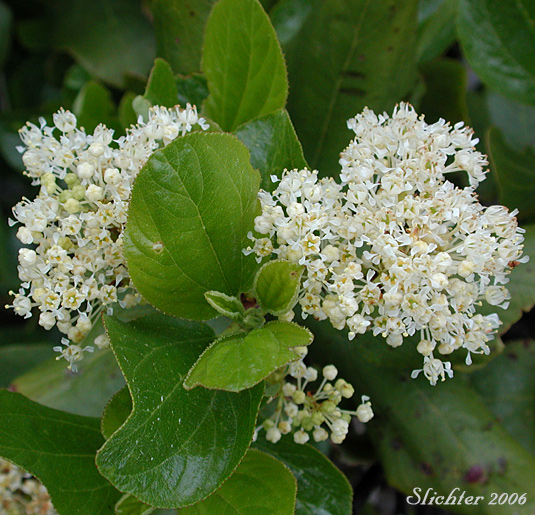
Snow brush is a sprawling evergreen shrub which is very aromatic. It ranges from 50-200 cm high. The young twigs are minutely puberulent to smooth. The leaves are alternate along the stems with 1-2 cm petioles. The leaf blades are ovate to ovate-elliptic in shape and range from 5-10 cm long. Individual leaves are thick and leathery in cross-section. The upper surface of the leaves is a shiny (but sticky) green and is often bronze-tinged. The lower surface ranges from smooth to grayish haired and has a velvety texture. Three prominent veins are found on the leaf surface and the leaf surface often curls downward and has many tiny, glandular teeth (See leaf photo at right and below.). The leaf emits a sweet aroma during warm weather. As the leaves curl strongly downward during warm summer weather, water loss is minimized as exposure to the lower leaf surface is reduced.
The white flowers are borne in large, dense pyramidal shaped panicles. Individual flowers are small. The fruit is a barely crested, deeply 3-lobed capsule. Each capsule lobe contains 1 seed. The capsules explode following intense heat to disperse the seeds.
Snow brush is also known as mountain balm, sticky laurel, greaswood, and tobacco brush. It is useful as a nitrogen-fixing plant. The flowers make a soapy lather when crushed in water, and they provide a fragrance and softness to the skin after washing. The leaves were used by Native Americans for tobacco, tea, and a red dye. The palatability of the plant is low.
Snow brush may be found on open, sunny slopes and in dry, open woods. It is especially abundant on fire-frequented sites.
Snow brush may be found from British Columbia south along the Pacific coast to California, and east (in mountainous areas) to South Dakota and Colorado.
Snow brush is common along the southern and eastern slopes of Mt. Adams from 2000' up to about 6000'.